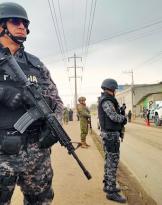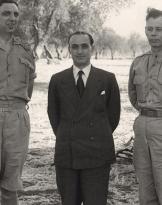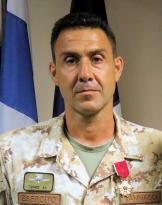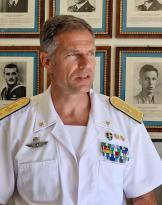Yesterday the Amphibious Assault Ship was launched in Castellammare di Stabia Trieste, financed and developed within the so-called second naval law (the first is that of the 1975 wanted by the then CSMM amm. sq. Gino De Giorgi).
Set in the 2017, at the Fincantieri shipyards in Castellammare di Stabia, the new Navy amphibious assault ship should be delivered in the 2022.
Named TRIESTE, it is a landing unit with a flight deck and floodable basin (LHD, Landing Helicopter Dock), with a standard displacement of approximately 30 / 33.000 tons (the largest military ship built by Italy since the end of the Second World War), with a total length of 245 meters.
The architecture of the LHD sees the presence of two islands: the one at the bow for naval operations and the one at the stern for controlling air operations. THE'hangar - long 107 meters and wide 21, with a minimum height of 7,8 meters and a surface of 2.200 m² - it has two large elevators that connect it to the flight deck, along 230 meters and wide 36.
Propulsion is ensured by a mixed diesel propulsion system for cruising navigation, in addition to gas turbines, for higher speeds.
TRIESTE will be able to embark a flight component of VSTOL helicopters and planes. The design of the flight deck and the hangar took into account the possibility / opportunity to also board Allied Marine aircraft other than those supplied to our Navy to increase interoperability in international coalition operations. These aircraft include the MV 22 Osprey, the CH 53.

The new unit was designed to transport and project a strong amphibious contingent centered on a tactical group of 600 men to the ground.
The “garage” is about 4.500 m², capable of accommodating also the ARIETE MBTs and the heavy CENTAURO II busways. A lateral ramp will facilitate the access of vehicles and personnel on board. The dock is able to accommodate, in addition to those supplied to the Navy, landing craft with air cushion and variable geometry catamarans of the French National Navy. In addition, 4.600 mᵌ of fuel, 350 tons of ammunition and 600 mᵌ of drinking water will be stowed. The Unit is equipped with a large and well-equipped hospital with modern NATO standard triage stations.
As for the armament, the TRIESTE will be equipped with three SUPER RAPIDO cannons from 76 / 62; there are also the volumes available to install even anti-aircraft missiles, surely 25 mm remote control cannons will be installed to counteract the possible threat of small fast units / asymmetric threats.
Yesterday there was a great absentee at the ceremony. Online Defense has reached the real "father" of the Trieste, adm. Giuseppe De Giorgi, to have an authoritative opinion on the new unity, beyond the official propaganda and "forgotten" merits.
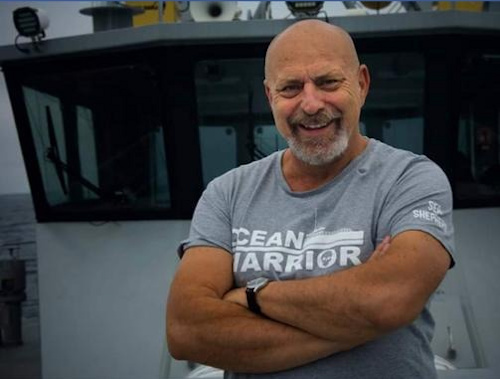 Admiral, the amphibious assault ship was launched yesterday Trieste, the largest military ship built in Italy since the post-war period, as part of the fleet renewal program that she so strongly desired, commonly known as "naval law". What considerations you feel you are making at this time.
Admiral, the amphibious assault ship was launched yesterday Trieste, the largest military ship built in Italy since the post-war period, as part of the fleet renewal program that she so strongly desired, commonly known as "naval law". What considerations you feel you are making at this time.
I feel a sense of pride and gratitude for the men and women of the Navy who have played an active role both in the "conquest" of political consensus and public opinion for a long-term intervention aimed at preventing the extinction of national maritime capacity around a decade, both in the implementation phase of the company. I refer in particular to the staff of the Naval Staff and of the Navarm Technical Management guided by the Amm. Bisceglia. Without the teamwork of these two fundamental pillars of the Armed Forces, it would not have been possible to accomplish the miracle of obtaining the necessary funds from the Parliament, developing the projects of the ships, overcoming the quicksand of the inter-force "burocràtzia" and going to contract with all program vessels in just three years.
A decisive part was played by the re-born Office of the Naval Staff Department, which I strongly strengthened with some of the most talented engineers of the FA.
Can indicate for which features the Trieste is it particularly significant?
In the first place I wanted a ship sized for the tasks to be performed and not a maximum tonnage established a priori on political considerations, without the prejudices and psychological conditions that have affected many Navy projects in the past. I refer in particular to tonnage. Too often we have ended up giving the displacement an "ideological" value as if the extra tons were a disvalue, with the risk of paying dearly anyway for a ship that would always be missing "the money to make a lira".
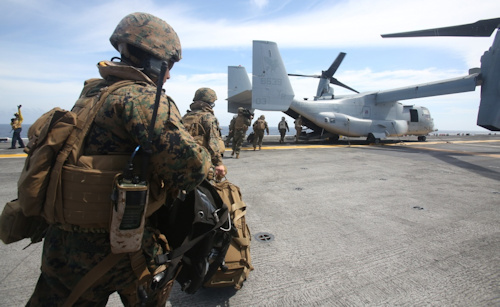 I wanted Trieste to be a multi-purpose ship, operationally effective and not an image ship. I wanted a ship in line with the standards of the best NATO Marines. Hence its maximum displacement which, not by chance, is in line with the best analogous units in the United States, the Spanish French, etc. Trieste can continue to operate effectively even in rough seas and in distant seas. Its characteristics also make this ship an important asset for supporting national civil protection in the event of natural disasters.
I wanted Trieste to be a multi-purpose ship, operationally effective and not an image ship. I wanted a ship in line with the standards of the best NATO Marines. Hence its maximum displacement which, not by chance, is in line with the best analogous units in the United States, the Spanish French, etc. Trieste can continue to operate effectively even in rough seas and in distant seas. Its characteristics also make this ship an important asset for supporting national civil protection in the event of natural disasters.
To increase the interoperability with the other Marinas, the unit is equipped with a floodable basin designed to accommodate air-cushion vehicles supplied to the American Navy, French vehicles, etc. in addition to as many as four large motorcycles (60 tons) of national production. The same flexibility and margin of growth was adopted for the arrangements of the air component. Also in this case the flight deck must be able to accommodate not only the vehicles supplied to Italy but also the OV 22 Osprey and the heavy helicopters CH 53 of the Marines. Italy will soon have a very high performance platform with which to contribute at least (qualitatively) with allies to international missions as well as those defending national interests.
Could you explain why you wanted to adopt the two-island solution?
I wanted a solution that would minimize the flight deck area removed from flight operations. A defect present both on the Garibaldi and on the Cavour that have both islands too large compared to the tonnage and the surface of the flight deck. At the same time, I wanted to avoid concentrating the exhaust ducts in a single smokestack both for reasons of vulnerability and to contain the internal encumbrances caused by long connecting pipes.
By positioning the two islands around the two funnels, placed on the vertical of the engine rooms, all this was obtained with the further advantage of having superstructures far enough from each other to support active and passive sensors, minimizing mutual electromagnetic interference. The same logic led to the two islands of the Queen Elisabeth.
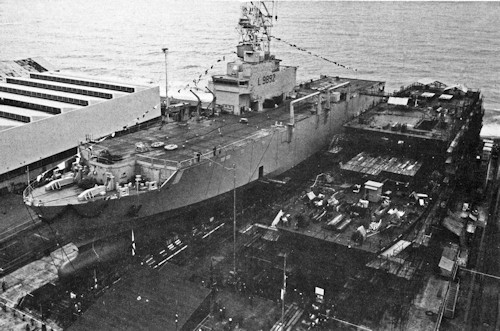 What will the entry of the LHD Trieste for the amphibious capacity of the Navy entail?
What will the entry of the LHD Trieste for the amphibious capacity of the Navy entail?
In terms of operational effectiveness, Trieste represents a remarkable leap in quality compared to the Santi class (Photo) which, as not everyone knows, were a derivative of the "Poets" class ferries destined for the State Railways. A makeshift solution, dictated by economic constraints, useful for keeping alive the amphibious capacity of the Armed Force in times of lean cows, but units too small to be effective in the presence of opposing opposition. It is only thanks to the expertise of their crews and their captains that they have operated well above legitimate expectations.
If from a qualitative point of view the step forward is macroscopic, the same cannot be said from the quantitative one. It is clear that the new ship will not be able to replace both the Garibaldi (today mainly dedicated to the role of Assault Helicopter Carrier) and the 3 "Saints". An amphibious component based on a single ship vanishes when that single piece becomes unavailable for maintenance or breakdown. Hence the need to have at least 3 other amphibious units albeit of different sizes and characteristics. I am thinking of the LPD 17 USA with some improvements in terms of versatility (eg greater anti-aircraft capacity and fire support for amphibious troops).
Why the name Trieste? His successor tried to change the name, but without success.
The name is a tribute to the city of Trieste, on the occasion of the centenary of the First World War and a recognition of the very strong bond between the Navy and the city of Trieste, never dormant. These were among the main reasons for my choice. I believe that Trieste deserves a ship dedicated to her and I think that the union between the City and the Ship has been and will continue to be a harbinger of positive developments. It would be nice if other ships were baptized with city names that adopted them and could be proud godmothers. For this reason, when Girardelli tried to change its name, the City made itself felt through its various souls, both from civil society and political representatives, imposing a hasty backtrack.
 Today many expected that the Authorities present at the launch, including in particular his successor, Ad Girardelli, would have cited it to acknowledge the paternity of this beautiful and impressive ship and more generally of naval law. Incredibly even on this occasion this did not happen. It seems to me that we are in the presence of a real "damnatio memoriae".
Today many expected that the Authorities present at the launch, including in particular his successor, Ad Girardelli, would have cited it to acknowledge the paternity of this beautiful and impressive ship and more generally of naval law. Incredibly even on this occasion this did not happen. It seems to me that we are in the presence of a real "damnatio memoriae".
Yes I see now that it is a bad name that has consolidated in this last three years and that seems to me to be foreign to the style of the Armed Forces and counterproductive for those who manifest it, given that the personnel of the Armed Forces and not only, is perfectly aware of the merits of the individual Chiefs who have followed, of their professional history, etc.
What I regret to note is that in addition to the undersigned, all the excellent Defense / Navy Officers, NCOs, Graduates and civil servants who gave their soul to the naval law for the design were included in this maramaldsca "damnatio memoriae". of new ships, from conception to their contractualisation, before the end of my mandate, in order to secure the funds from foreseeable subsequent coups. It is a result that honors the Navy as a whole and that does not deserve to be belittled or kept silent just because they were not creators or an active part.
Photo: Fincantieri / Department of Defense / Sea Shepherd / US Marine Corps




